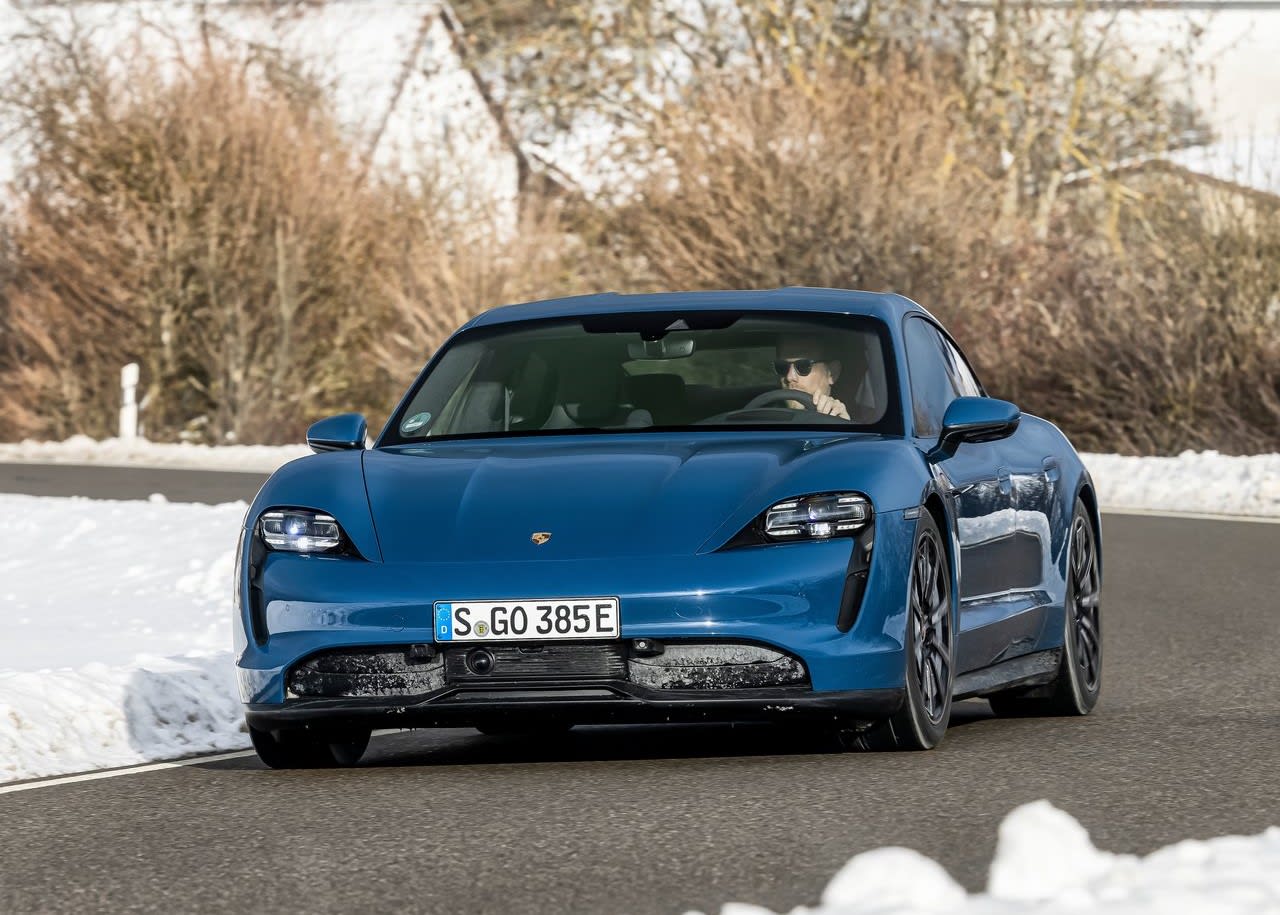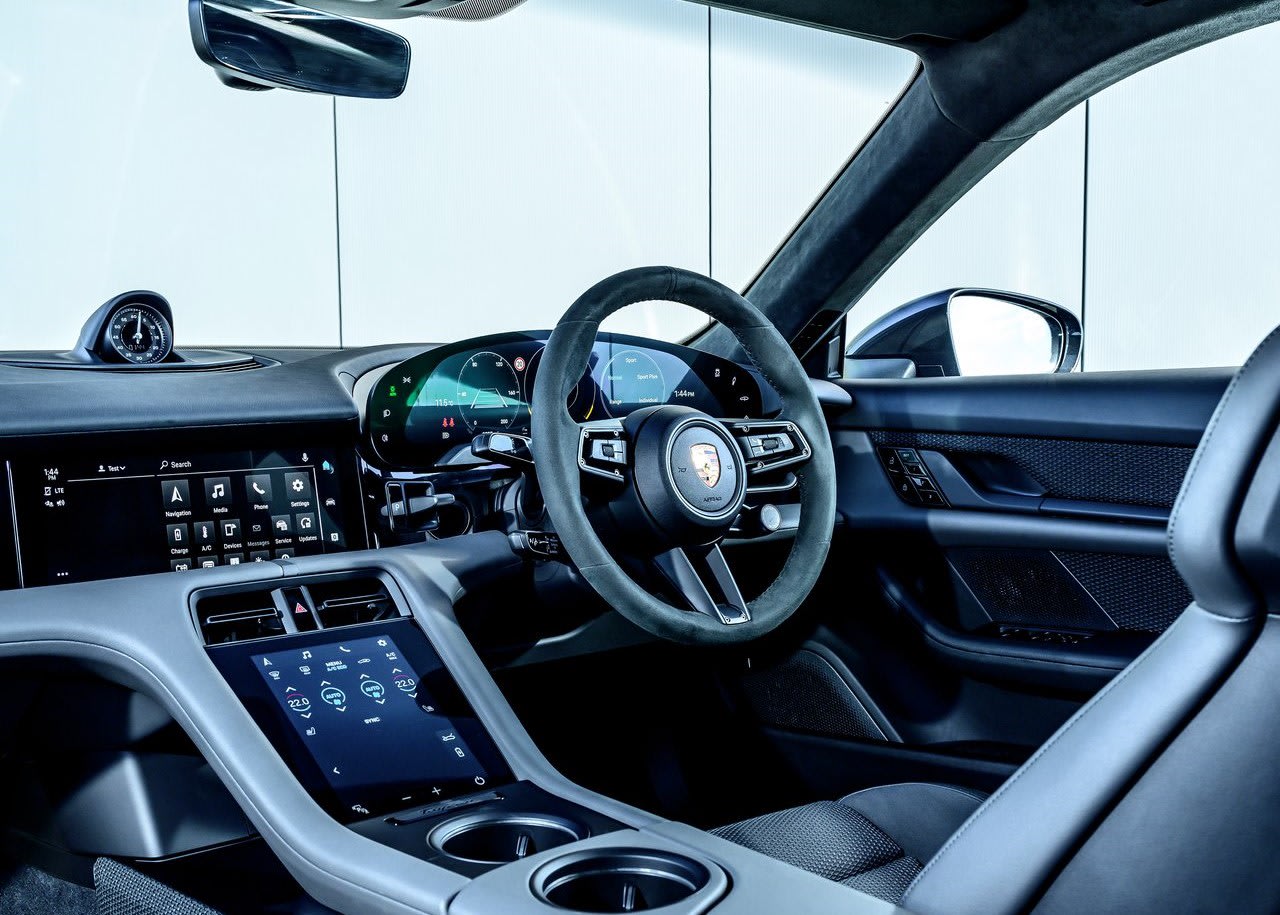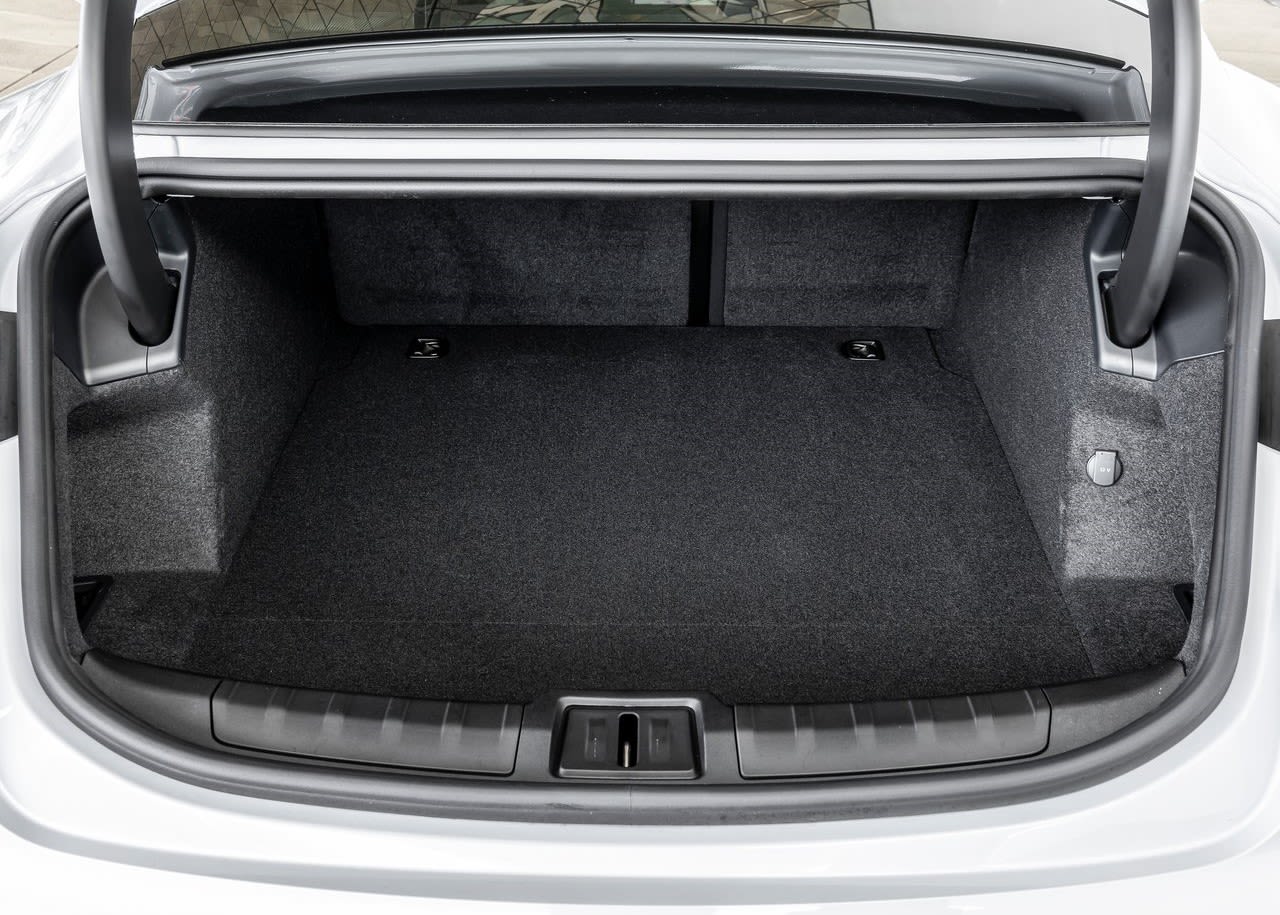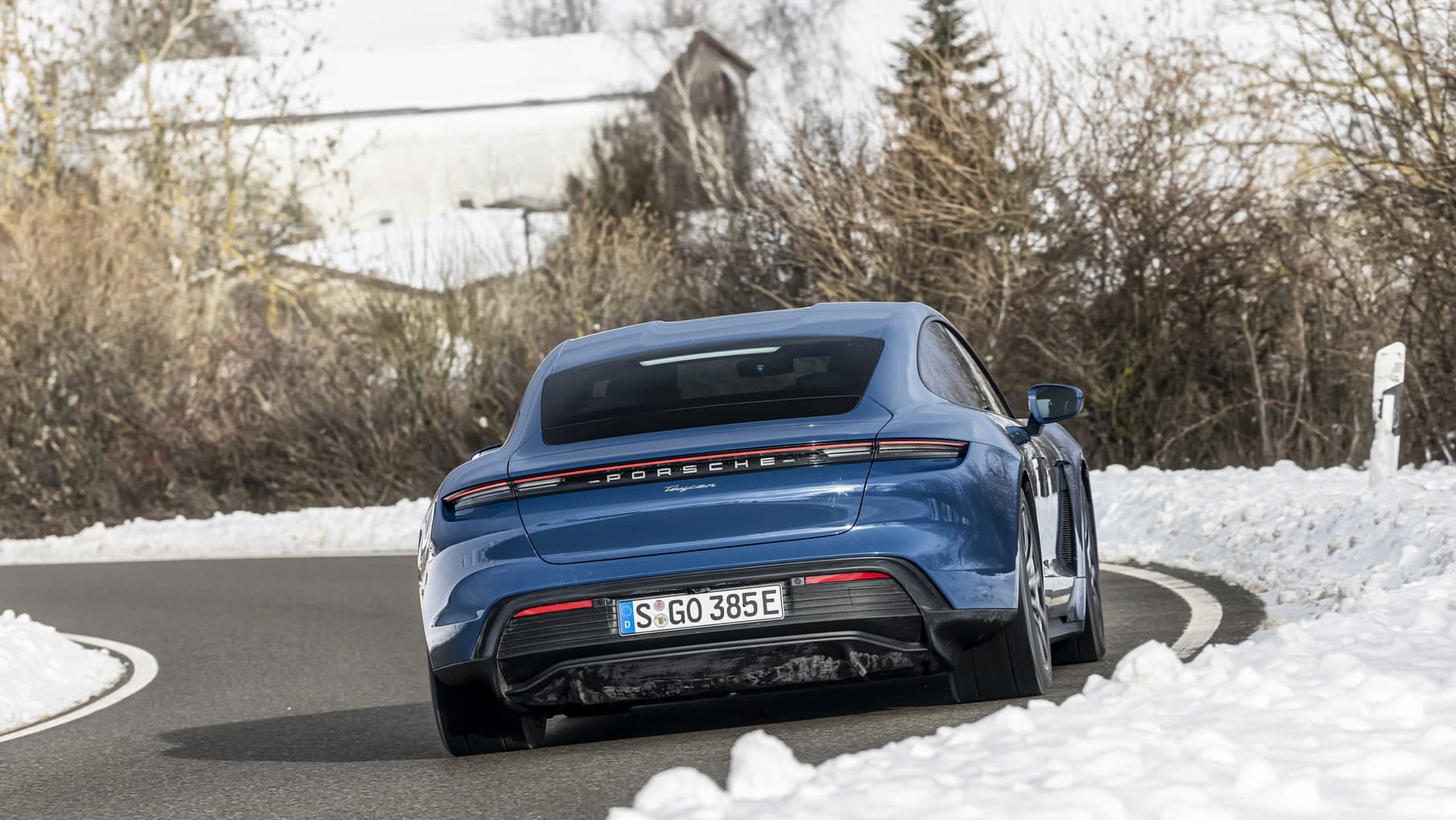
Porsche Taycan Review

Introduction
The Porsche Taycan is a sleek four-door sports car not entirely dissimilar to its sibling, the Panamera. The difference is that it’s all-electric, making this Porsche’s answer to the likes of the Tesla Model S.
It’s the first foray for the famed premium marque into the world of the all-electric car. Being Porsche, it had to bring its technological might to the fore and lead the way in some respect which, in this instance, means it’s the first electric vehicle (EV) to feature a sturdier 800-volt electric architecture. It's complex, but means the batteries stay cooler, allowing for repeatable performance and safer high-speed charging.
That's just the starting point of what makes the Taycan special...
Review Sections
Select's rating score* - 4.6 / 5
At a Glance
The times they are a-changing. It’s a fact of which Porsche and its sibling VW Group brands are all too aware. So-called disruptor Tesla has been running away with the flourishing EV market with its convincing range of all-electric cars for a couple of years now. Bans loom large on the horizon in markets the world over too on the sale of new fuel-burning cars. The Taycan is Porsche taking action to respond and adapt, on both fronts.
Tesla has the benefit of being the hot new thing. Porsche, meanwhile, has top-tier long-standing legacy brand power, with a near-unparalleled heritage in and reputation for engineering and quality. New to the EV game though it is, no less than the best is expected. It has to be a good car, a good EV and perhaps most importantly, a good Porsche.

So while it doesn’t benefit from a comprehensive own-brand charging network, the claim is that it drives, performs and is built to a high standard that a Porsche should be, with bleeding-edge tech buyers can trust.
Key Features
You might think that supercar-rivalling performance or a luxury-car specification might be the talking points for the Taycan but, surprisingly, environmental performance is a critical part of the Taycan’s offering.
Yes, an electric car offer zero-emission driving, but that power has to be produced somewhere, and the car has to be built in an energy-intensive process. The UK’s power grid is getting greener, which means pollution will drop year on year as you drive the Taycan, which is good news.
However, the factory side of things hasn’t been forgotten. Porsche says production of the Taycan is already carbon-neutral, with the factory in Stuttgart-Zuffenhausen embracing new technology to improve energy efficiency and environmental friendliness. That’s already achieved the Taycan production milestone, but there’s more to come, with Porsche insisting that the Taycan will not just be a zero-carbon product, but that the factory will be a zero-impact production facility.
Who knew that being able to go fast also meant you could go green?
Performance & Drive
You can get your Taycan delivered with 761hp if you opt for the Turbo S model, which is more powerful than the Ferrari F8, or around three-quarters of a modern Formula 1 race car. The difference is that, while an F1 car weighs in at 740kg, the Taycan - in any of its forms - tips the scales at more than two tonnes.
.jpg)
If you think that might affect the car’s performance, then, well, you’d be right. However, while all of those batteries add a lot of mass to the car, it’s all been placed so low in the car that the centre of gravity is lower than you’d find in most other cars. The result? Handling that’s more agile than you would ever expect.
The steering is a joy. Unusually for a modern vehicle, you feel directly connected to the front wheels, with accurate and precise steering that builds up weight nicely as you explore the capabilities of the car. The body resists roll exceptionally well, which inspires confidence, enabling you to extract the maximum performance possible from the huge 275mm wide tyres.
Straight-line performance is incredible, with the Turbo S accelerating to 62mph in a barely believable 2.8 seconds. We’ve got the more leisurely 4S version although, with 435hp, it’s no slouch. At four seconds dead, it’s still a match for many a supercar, helped by a momentary power boost to 530hp when launching from a standstill. Even the entry-level model, with its modest 326hp, is a proper sportscar.

You need the 4S model or above to benefit from four-wheel drive, created by adding another electric motor to the front of the car, which is what propels the car forwards so ferociously.
None of that is at the expense of ride quality. The Taycan is stiff, of course, but there’s a suppleness to the suspension that makes it surprisingly capable of dealing with the worst of the UK’s roads - at least on the 19-inch wheels of our test car. Turn the suspension up to Sport or Sport Plus mode and it crashes around a little, so stick with the normal settings for touring the country. Without putting them to the test, we’d assume the 21-inch wheels fitted on higher models will add a slightly harsher edge.
Running Costs
Much like cars you fill with either petrol or diesel, if you put your foot down, the Taycan will burn through its battery reserves at a rate of knots. Likewise, if you’re an energy-conscious driver, you could find yourself surprised by its efficiency. Pick a Performance Plus battery-equipped rear-wheel-drive version and a WLTP-verified range of 301 miles is claimed (the lower-capacity 4S tested here doesn’t fare quite so well, with an official range of 254 miles) and, with particularly careful driving, you might just about manage to cover that distance before needing to plug in, The real world, chilly days, and the ever-present urge to put your foot down and revel in the power of the Taycan can see that slip quite a bit, though.

Whatever range you’re getting, however, you’ll likely be ‘filling up’ for far less than the cost of some unleaded. Charging at home costs around 15p per kWh (at the time of writing) so an empty-to-full charge of the 4S will cost around £12. A professionally installed home charger is recommended, as that charges more quickly - plug into a three-pin socket and it could take 24 hours to fully juice it up - but top up when you’re out and about, especially on motorway charger units, and costs could soon rocket.
No engine means there are no emissions from the car, although the power has to be generated somewhere. In the UK, whatever measure you use, EVs pollute less than petrol or diesel models, and that’s reflected in the tax rates. Company car drivers will benefit from a BIK rate set at just 1% for 2021/22, and that rises to just 2% for the next two years. That guarantees cheap motoring for almost the duration of a three-year lease deal.
Interior
Forget BMW claiming that it makes the ‘ultimate driving machine’, as it’s Porsche that puts the driver first. You sit low down - surprisingly so, as there are battery packs hidden under the floor - giving the Taycan a sporting dynamic. The seats are comfortable and supportive, really holding you in place under more enthusiastic moments, even if, like me, you’re a little more substantial than many.

You’re ensconced in a cabin that could leave some feeling a little claustrophobic, but there’s no doubt that it looks ad feels great. Three large digital screens dominate the view, one working as the instrument panel behind the steering wheel, a now-traditional 10.9-inch infotainment screen high and centre, and a long 8.4-inch panel sitting low in the centre console. Between the two in the middle, you get to control everything within the car, but it’s not always intuitive. Finding icons and buttons while driving can be tricky, and haptic feedback does little to aid matters, especially as you can easily catch the panel while trying to reach for buttons on the higher screen.
Life can be made easier with smartphone mirroring, and wireless Apple CarPlay is available in the Taycan. However, Android Auto is notable for its absence, although Porsche says it’ll be coming to future models.
You can splash out on another screen for the passenger. Yes, your co-driver can sit there with their won speedometer, fiddle with the navigation or, and this could be dangerous for relationships, change what music is playing.
It’s all very tech-heavy, but there are more hits than misses. It’s all wrapped up in a cabin that offers exemplary quality, feeling more premium than its Tesla rival and, frankly, almost every other car on the market.
Technology
Being an EV and being a Porsche, the Taycan can be fairly described as tech-laden. On the inside, the driver is greeted by a curved configurable digital instrument cluster with traditional ‘dial’ graphics. It’s one of a possible four screens that you can find dotted around the dashboard if the passenger display (£725) is optioned.

Standard across the range is a centrally mounted 10.9-inch infotainment display, while below that sits a digital touchscreen control for climate, seat temperatures and more. You can even talk to your Taycan by saying ‘Hey Porsche’, followed by several possible commands, although this is rather hit and miss. No manufacturer has quite managed to equal the capabilities of Google or Alexa yet.
A number of semi-autonomous and ‘assist’ systems can be optioned. The clever ‘InnoDrive’ advanced cruise control system (£2,172) is the cream of the crop. It incorporates lane-keep and adaptive cruise systems, with a predictive capability of up to 3km.
Practicality & Boot Space
If you think the Taycan looks a little like a less practical Panamera, you’d be about right, but there’s not that much in it. There feels to be just as much space in the front, and maybe more than you’ll find in a Tesla Model S, and there’s just as many storage options dotted around, too.
The rear seats are strictly for two, so there’ll be nobody being disappointed at getting the middle seat. They’ll be disappointed about not going anywhere instead unless you splash out for the optional third seat. I probably wouldn’t bother.
Headroom is acceptable, if not generous, while legroom is suitable for an average adult. Those with particularly long legs will suffer, but most others should be able to get comfortable enough.

Those rear seats even split and fold, allowing longer loads to be slotted into the boot. At 366 litres, it’ll do for a weekend away but it’s not overly generous. For comparison, a Volkswagen Golf provides 380 litres of cargo space. Still, it’s enough for a set of golf clubs, and there’s some extra space available under the bonnet for a small squashy bag.
Safety
Porsche took home a five-star rating from safety testing outfit Euro NCAP, confirming that electric cars are every bit as safe as more traditional models. However, it only just squeaked through thanks to front seats and head restraints that “demonstrated marginal protection against whiplash injuries in the event of a rear-end collision.”
Despite that, the comprehensive suite of advanced driver-assist systems (ADAS) should minimise the chance of an accident in the first place. The automatic emergency braking was specifically praised, while an optional InnoDrive system provides some semi-autonomous systems to keep the Taycan on the straight and narrow.
Options
As is increasingly becoming the case with Porsches and indeed other premium marques, the scope for specification and customisation is, much to your accountant’s despair, near-on limitless. You can spend up to £5,636 on a wheel option for the 4S, for example.
You can spend over £4,000 on two-tone Club leather and up to £1,440 on the adaptive sports seats that it clothes. A Burmester stereo is £4,200, matrix LED headlights will set you back at least £1,221 and a panoramic roof is £1,137. Add in InnoDrive for over £2,000 and you could be forgiven for wondering if you’re being conned at base price.

Happily, some things are just de rigueur these days. Climate control, basic cruise control (if you want adaptive cruise, that’s extra), a compelling stereo system with Bluetooth connectivity – there’s everything you need in normal driving in a Taycan fitted as standard. That options list does make for stomach-turning reading, though...
Rival Cars
Considering rivals for the Porsche Taycan is a curious one. Get yourself a Turbo and it’ll happily rival the petrol-powered BMW M8 in terms of performance. Really, though, the Taycan is a response to the Tesla Model S; there are multiple specifications, a large range of prices, and even the marketing gets a little punchy. Porsche’s claim of ‘repeatable performance’ courtesy of that 800-volt architecture is another way of pointedly saying a Tesla will wilt after a few strong 0-60 runs.
Practically, however, a Model S is a fine car. The tech is great, the range and performance are extraordinarily impressive and the fantastic Supercharger network is difficult to ignore. If you’re unfazed by people making judgements about what Tweet-happy moguls you may or may not follow, it’s a worthy machine, if a little long-in-the-tooth - something you can’t escape when comparing the external design to the Porsche.

If you’re just looking for a fast luxurious and sleek four-door without mind paid to what powers it, the usual suspects remain. There’s the Audi A7 (or higher performance S7 and RS7), the BMW 8 Series Gran Coupe (and higher performance M8 Competition Gran Coupe) or the Mercedes-Benz CLS Coupe (and higher-performance AMG CLS 53) – with a Taycan budget, this fast, fabulous and predominantly German world is your oyster.
Verdict
Elon Musk might talk about his self-driving cars (they don’t drive themselves, and the Autopilot name is quite a dangerous misnomer) but that’s not what Porsche is about. Porsche wants you to drive its cars, and the Taycan offers you the performance, security and engagement that you would expect from a car from Stuttgart
At the entry level, it’s also relatively sensible and doesn’t cost a crazy amount. Move up the range and the price tag increases just as quickly as the performance figures improve, but those numbers don’t tell the whole story.
If you’re cruising across a continent, the softer Tesla Model S might be preferable, especially with its longer electric range, but the Taycan offers an exemplary balance between everyday comfort and useable performance.
Where to next?
View latest Porsche Taycan leasing deals - guide price from £837.59 per month inc VAT**
Looking for a great leasing deal? Check out our incredible range of car lease deals
New luxury sports car? Read our latest Reviews and find the right model for you
Want to know more about leasing? Take a look at our comprehensive Leasing Guides
Interested in everything motoring? Why not catch up on all the latest Car Leasing News.
*Score based on Select’s unique meta score analysis, taking into account the UK’s top five leading independent car website reviews of the Porsche Taycan
**Correct as of 13/05/2021. Based on 9 months initial payment, 5,000 miles over a 48 month lease. Initial payment equivalent to 9 monthly payments or £7538.29 Ts and Cs apply. Credit is subject to status.





















